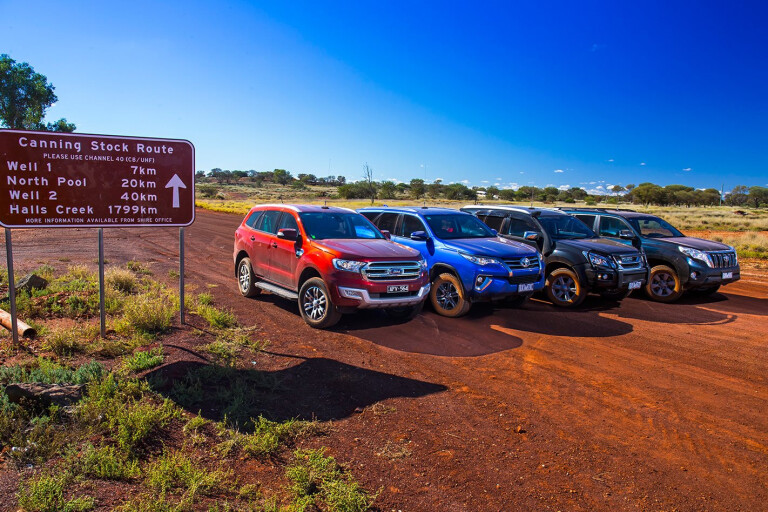
HEADING north out of Perth gave us time to contemplate just how much the 4x4 market had changed over the past decade.
Leading the convoy was an old favourite, the Toyota Prado. The model first arrived in 1996 as an antidote to the increasingly pricier LandCruiser king, and it has since cemented itself as an outback prince.
Next in the convoy was Toyota’s Fortuner. The Prado was once a circa-$40K off-roader but now commands half that again for the volume-selling GXL. So the Fortuner has been born as the most affordable diesel entry to Toyota’s off-road brigade.
Isuzu’s MU-X is another relative newcomer, having first surfaced in 2013. It sports a proven ute and truck heritage in a no-nonsense seven-seat shell.
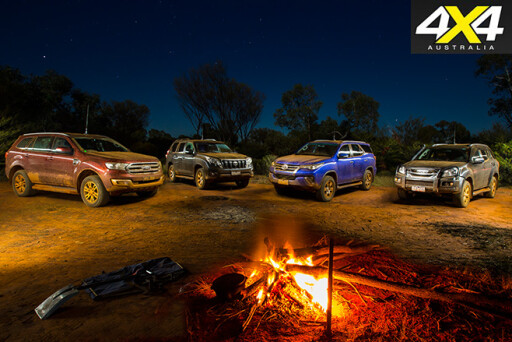 But it’s the Ford Everest that is the freshest of our quartet – and it’s a four-wheel drive with plenty to prove. Straight out of the blocks the Everest cleaned up at the 2015 4x4 Of The Year testing.
But it’s the Ford Everest that is the freshest of our quartet – and it’s a four-wheel drive with plenty to prove. Straight out of the blocks the Everest cleaned up at the 2015 4x4 Of The Year testing.
All of which meant nothing as we steamed up the Great Northern Highway towards Meekatharra before heading east to Wiluna, the southern start of the Canning Stock Route. Sure, we’ve tested the off-road mettle of the Everest, but we haven’t put it through a punishing outback test, one where reliability, comfort and ability are priorities.
When the wheels touched dust for the first time, it was a tantalising taste of the 2000km of tough, remote country that lay ahead. With close to 1000km of highways at either end, it promised to be the ultimate off-road test.
1. TOYOTA PRADO
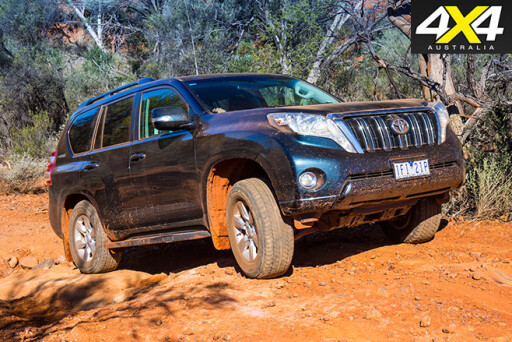 THE Prado clearly stands out. Its chassis is shared with that of the American Tacoma ute, but its body is unique and larger than most in its class. That said, the Prado has a shorter wheelbase than the MU-X and Everest.
THE Prado clearly stands out. Its chassis is shared with that of the American Tacoma ute, but its body is unique and larger than most in its class. That said, the Prado has a shorter wheelbase than the MU-X and Everest.
Still, interior space is great, from the adjustable rear seats to the tall roof that increases the sensation of space. That’s something noticeable inside, where there’s plenty of room for a family, especially across the cabin. Three-zone air-conditioning is a win, too, allowing those in the rear to adjust temperatures.
But for $61,990, the Prado isn’t spectacularly well-equipped, missing out on trinkets such as smart key entry (increasingly common in this market) and making do with basic seat trim. Yet other touches help justify its price premium, such as the 220V power point in the back.
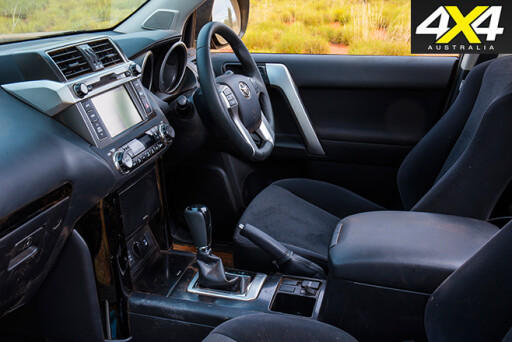 The extra interior roof height and folding seats meant it was the designated water-carrying car. By the time we’d loaded it up with drums, an extra spare tyre and some camping gear it was close to its 2990kg GVM. That GVM may sound high, but the Prado is no featherweight to start with – 2.3 tonnes – so it’s pretty easy to hit that limit.
The extra interior roof height and folding seats meant it was the designated water-carrying car. By the time we’d loaded it up with drums, an extra spare tyre and some camping gear it was close to its 2990kg GVM. That GVM may sound high, but the Prado is no featherweight to start with – 2.3 tonnes – so it’s pretty easy to hit that limit.
As a result, the suspension was quite soft in the rear, making it prone to the occasional under-belly scrape. It was more noticeable on faster sections with big peaks between wheel tracks. Perhaps the 220mm of ground clearance didn’t help (it was at least 5mm less than the claim of its three rivals), although we’ve never had issues with the Prado’s clearance before. This is where the more expensive Kakadu’s self-levelling rear air suspension may have come in handy, as well as the VX and Kakadu’s KDSS suspension that gives better body control.
Points are made up with the full-time 4WD system. It’s a small thing, but being able to roll into Halls Creek without having to worry about disengaging the front wheels simplifies things. With a decent traction control system it meant we never needed the centre locking diff.
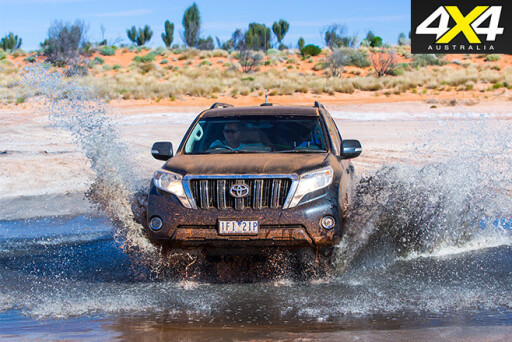 The Prado is beginning to show its age on the inside. Its sizeable slabby dash displays the navigation system close to the driver’s line of sight. That dash disliked the Canning’s unforgiving corrugations, jumping around like a hyperactive two-year-old.
The Prado is beginning to show its age on the inside. Its sizeable slabby dash displays the navigation system close to the driver’s line of sight. That dash disliked the Canning’s unforgiving corrugations, jumping around like a hyperactive two-year-old.
Not that anything ever separated from where it should have been. The Prado is a tough beast and one that dealt admirably with the blows. Importantly, it was comfortable. The chunky steering wheel tops off a decent driving position, too.
Further aft the Prado is one of a rare breed of modern off-roaders with a swing-out door, which is both a plus and a minus. The big plus is how easily accessible it makes the spare wheel; although, for quick roadside stops it lacks the sun or rain protection a rising tailgate can provide.
The big change in the Prado, that is otherwise largely unchanged since the 150 Series arrived in 2009, is the engine. Despite its newness, the 2.8-litre is somewhat underwhelming, particularly when paired with the heft of the Prado. It isn’t overloaded with grunt – although the 450Nm is pretty handy and arrives with gusto by 1600rpm, ensuring effortless mid-rev progress.
 Despite having the lowest claimed fuel figure of our quartet, 8.0L/100km, the Prado was the thirstiest in the real world, using 14.9L/100km – at least 15 per cent more than its nearest rival. That said, it was carrying a heavier load.
Despite having the lowest claimed fuel figure of our quartet, 8.0L/100km, the Prado was the thirstiest in the real world, using 14.9L/100km – at least 15 per cent more than its nearest rival. That said, it was carrying a heavier load.
No complaints with its fuel capacity. At 150 litres it’s the biggest standard tank in a production car (see ‘Fuel for Thought’ sidebar), something that allowed it to travel the entire CSR without anything more than the regular refuel about mid-way through.
Specs: Toyota Prado GXL
Price: $61,990
Engine: 2.8-litre 4cyl turbo-diesel
Maximum power: 130kW @ 3400rpm
Maximum torque: 450Nm @ 1600-2400rpm
Gearbox: six-speed automatic
4x4 system: full-time dual-range
Crawl ratio: 36.1:1
Tyre spec: 265/65R17 A/T
Kerb weight 2315kg
GVM 2990kg
Payload 675kg
Towing capacity 2500kg
Fuel tank capacity 150L
ADR fuel use claim 8.0L/100km
Test fuel use 14.9L/100km
Touring range 957km
Ground clearance 220mm
Wading depth 700mm
Approach angle 32.0
Departure angle 25.0
Rampover angle 22.0
L/W/H/W 4930/1885/1890/2790
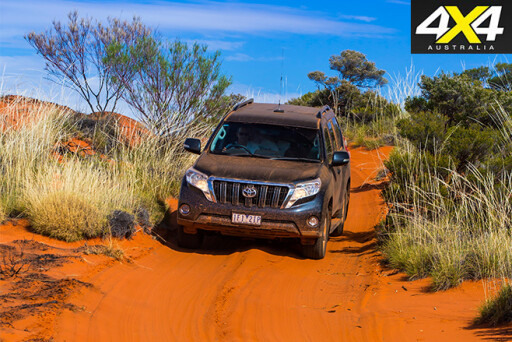 False Economy
False Economy
The fuel-consumption figures on the yellow windscreen labels on all new cars sold in Australia relate to Australian Design Rule 81/02. In this test, the vehicle isn’t driven in the real world but instead run through a test sequence in a lab, on rollers.
The test covers a theoretical 11km and is done in two parts; the Urban Cycle consists of a cold start then a series of accelerations, steady speeds, decelerations and idling. The maximum speed is 50km/h, the average is 19km/h and the distance ‘covered’ is 4km.
The Extra-Urban Cycle is conducted straight after and consists of steady speed for about half the test, with acceleration, deceleration and idling for the other half. The average speed is 63km/h with one spike to 120km/h. The distance is 7km.
The Urban and Extra-Urban figures are quoted separately and tallied for the Combined Cycle. Combined Cycle figures are consistently lower than real-world figures, the disparity seemingly increasing with engine and drivetrain sophistication.
2. TOYOTA FORTUNER
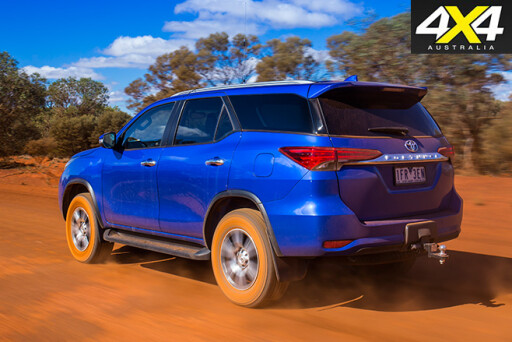 SMALLER and lighter than the Prado, the Fortuner’s biggest sales pitch is its price. We chose the GXL trim, at $54,990, which undercuts the Prado wearing the same nomenclature by $7000. Granted, you miss out on sat-nav, but it picks up smart key entry instead.
SMALLER and lighter than the Prado, the Fortuner’s biggest sales pitch is its price. We chose the GXL trim, at $54,990, which undercuts the Prado wearing the same nomenclature by $7000. Granted, you miss out on sat-nav, but it picks up smart key entry instead.
Still, with the Fortuner it’s easy to see where money has been saved. For example, the third row seats fold against the side of the car, taking up valuable luggage room. Occasionally, too, the straps holding them in place unclip, requiring a quick tighten up. There’s also only a single zone for the ventilation, so all occupants have to agree on the same temperature.
Like the Isuzu, the bonnet misses out on the Prado’s struts, so when it comes time to clean out the air filter you’re manually propping it open. Oh, and if you get a puncture, the spare that’s tucked underneath is only a steelie. Speaking of tyres, like the Prado the Fortuner gets tougher A/T tyres, whereas the Isuzu and Ford get H/Ts.
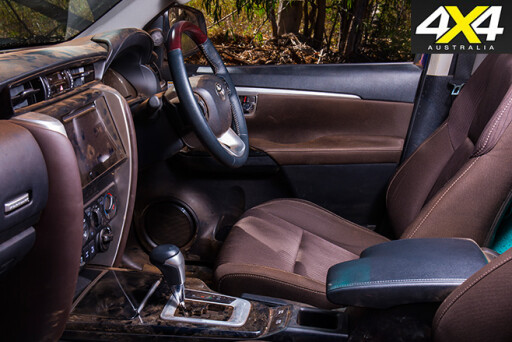 The Fortuner’s smaller stature is most noticeable with its limited head room and cabin width. That said, for a couple or a smaller family it’s adequately capacious.
The Fortuner’s smaller stature is most noticeable with its limited head room and cabin width. That said, for a couple or a smaller family it’s adequately capacious.
On the road the Fortuner immediately asserts itself as a capable companion. Its overly light steering that lacks meatiness on country roads is less of an issue once on the tracks of the CSR. It doesn’t take long for the Fortuner’s Hilux genes to shine through. Great ground clearance ensures it is well elevated over rocky sections, with ample articulation to keep the wheels in touch with the track.
The traction control system is also excellent, ensuring easy progress up sand dunes and through creek crossings. Less impressive is the suspension tune, especially in the rear. Dial up the pace and the coil springs soak up imperfections, but the movement is not as well controlled as it could be.
 At least the 2.8-litre engine gets on with things nicely. With less weight to deal with than the Prado, it’s fractionally more responsive, and the easy accessibility of its 450Nm rarely leaves you wanting. However, despite its 80-litre tank, the Fortuner often called for a drink sooner than its rivals, even though its overall fuel use hovered around an impressive 11.0L/100km.
At least the 2.8-litre engine gets on with things nicely. With less weight to deal with than the Prado, it’s fractionally more responsive, and the easy accessibility of its 450Nm rarely leaves you wanting. However, despite its 80-litre tank, the Fortuner often called for a drink sooner than its rivals, even though its overall fuel use hovered around an impressive 11.0L/100km.
The big difference between the Fortuner’s drivetrain and the Prado’s is the 4x4 system. The full time system has been replaced by the Hilux’s part-time setup, which in practice means it needs wider turns when manoeuvring in campsites or around tight turns.
Speaking of campsites, like the Prado the Fortuner insists on beeping every time it’s locked and unlocked; not really ideal if you want to dive into the cabin for a midnight snack.
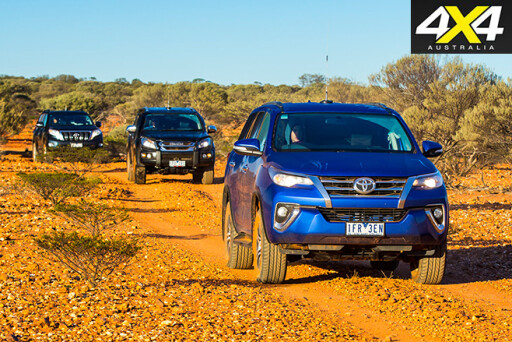 Specs: Toyota Fortuner GXL
Specs: Toyota Fortuner GXL
Price $54,990
Engine 2.8-litre 4cyl turbo-diesel
Maximum power 130kW @ 3400rpm
Maximum torque 450Nm @ 1600-2400rpm
Gearbox six-speed automatic
4x4 system dual-range part time
Crawl ratio 36.1:1
Tyre spec 265/65R17 A/T
Kerb weight 2110kg
GVM 2750kg
Payload 640kg
Towing capacity 2800kg
Fuel tank capacity 80L
ADR fuel use claim 8.6L/100km
Test fuel use 10.8L/100km
Touring range 690km
Ground clearance 225mm
Wading depth 700mm
Approach angle 30.0
Departure angle 25.0
Rampover angle 23.5
L/W/H/W 4795/1855/1835/2750
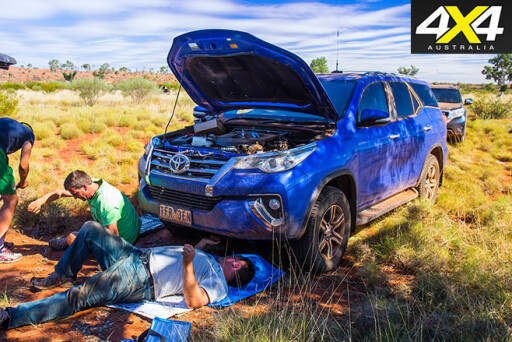 Cooling off
Cooling off
IN A remote area of the CSR the Fortuner threw up an engine warning and advised we visit a dealership. Best calculations had that as a three-day journey in either direction – and that’s if the car was driveable.
On popping the bonnet we noticed the coolant overflow was empty, and it didn’t take long to establish the lower part of the radiator had significant damage. Yet the exterior of the car had no damage.
The previous day the Fortuner was emitting a mild clunk from the front-end, something we initially suspected was a suspension component. But it appears it may have been a loose radiator from a broken bracket. It seems the radiator then jolted downwards and hit something above the sump guard, leading to holes on the core and lower tank.
Given the size of the hole we weren’t sure radiator stop-leak additives would work, so we spent hours removing the radiator to repair it with metal putty.
Our bush mechanic fix worked and we were on our way, with the Fortuner making it to Broome without another problem.
3. ISUZU MU-X
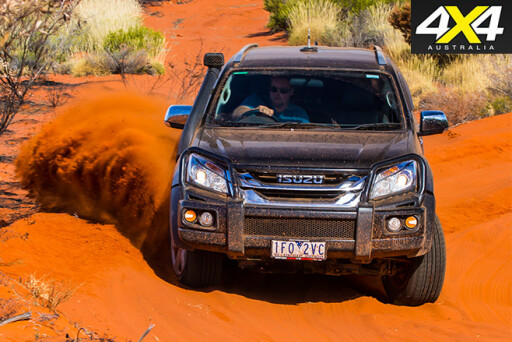 VALUE is a key sales pitch for the MU-X, something that makes it a popular choice for outback travellers. Its three rivals here required mid-spec models to get near our $60,000 target, but for the MU-X we went straight to the top of the tree, the LS-T. And even then, at $54,000, it left plenty in the pocket for accessories.
VALUE is a key sales pitch for the MU-X, something that makes it a popular choice for outback travellers. Its three rivals here required mid-spec models to get near our $60,000 target, but for the MU-X we went straight to the top of the tree, the LS-T. And even then, at $54,000, it left plenty in the pocket for accessories.
For that price, there’s plenty of extra kit such as leather seats, a powered driver’s seat, and a rear DVD screen to keep the kids content. Plus, it matches the Fortuner with smart key entry, while things such as the chrome doorhandles add a rare touch of bling.
On the inside it’s more about function than luxury and there’s nothing flashy about the presentation. The plastics and finishes look old school, although some streaks of silver help break up the dark greys. The storage binnacle atop the dash is a win for maps and other odds and ends, while the circular temperature selector is a snip to use on the move.
 Speaking of which, the MU-X’s seating position is quite high and its seats could do with more lateral support. On the cruise out of Perth, the MU-X felt the least composed of our assembled quartet.
Speaking of which, the MU-X’s seating position is quite high and its seats could do with more lateral support. On the cruise out of Perth, the MU-X felt the least composed of our assembled quartet.
Tipping into slower stuff, though, the seating position gives great vision, although we still wish there was reach adjustment for the steering wheel. Still, the MU-X began to thrive on the more challenging terrain, instantly feeling more in its comfort zone.
Its 230mm of ground clearance is the highest here and it was rarely caught out, while the part-time 4x4 system is no-fuss and effective, albeit without the addition of a rear diff lock (something the Everest and Fortuner get).
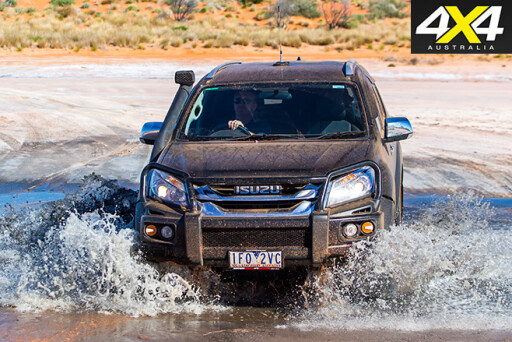 The MU-X somehow felt better on more challenging terrain, and its suspension deals admirably with big hits and corrugations; put that down partially to the ample articulation and relatively supple springs. Our shock temperature measurements (see ‘Shocking Stuff’ sidebar on page 58) showed they soaked up the least amount of heat.
The MU-X somehow felt better on more challenging terrain, and its suspension deals admirably with big hits and corrugations; put that down partially to the ample articulation and relatively supple springs. Our shock temperature measurements (see ‘Shocking Stuff’ sidebar on page 58) showed they soaked up the least amount of heat.
The 3.0-litre four-cylinder turbo-diesel engine is a gruff unit, always reminding you it’s chugging away, but the payoff is decent response. Its 380Nm peak is the lowest here by some margin, yet it’s easily accessible and quickly on-tap. And despite being down a ratio – it’s a five-speeder versus six for the rest – it never feels wanting once off-road, where slower speeds are the norm.
Its lithe weight no doubt played a part in helping it feel relatively sprightly. At 2075kg, the Isuzu carries less than its rivals. That also helps with fuel use and, despite a mediocre 65-litre tank, the MU-X returned impressive fuel figures. Its average consumption of 11.4L/100km made it one of the more frugal vehicles on this test.
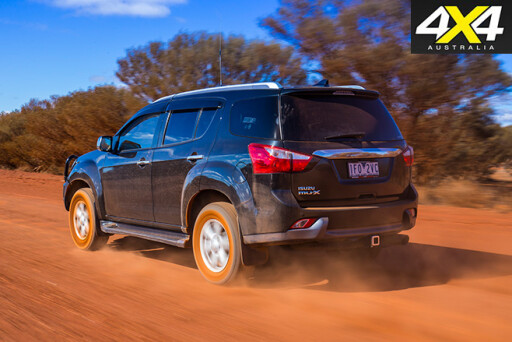 Specs: Isuzu MU-X LS-T
Specs: Isuzu MU-X LS-T
Price $54,000
Engine 3.0-litre 4-cyl turbo-diesel
Maximum power 130kW @ 3600rpm
Maximum torque 380Nm @ 1800-2800rpm
Gearbox five-speed automatic
4x4 system dual-range part-time
Crawl ratio 32.6:1
Tyre spec 255/65R17 H/T
Kerb weight 2075kg
GVM 2750kg
Payload 675kg
Towing capacity 3000kg
Fuel tank capacity 65L
ADR fuel use claim 8.3L/100km
Test fuel use 11.4L/100km
Touring range 520km
Ground clearance 230mm
Wading depth 700mm
Approach angle 30.1
Departure angle 25.1
Rampover angle 22.6
L/W/H/W 4825/1860/1860/2845
4. Ford Everest
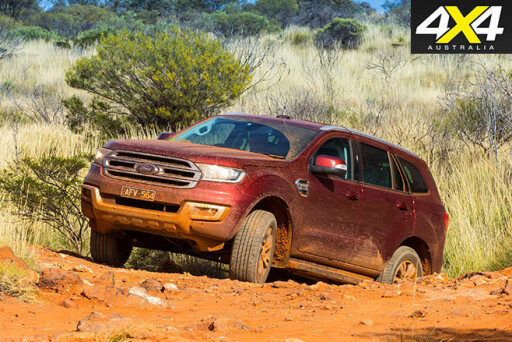 THE Everest arrived on the CSR with big expectations – mainly because we’ve been so impressed with it elsewhere – and it instantly asserted itself as a confident contender. On freeway cruises its active noise cancelling is a win, suitably hushing road and engine noise to the point where it is decibels quieter than its rivals. That makes a big difference when travelling big kays.
THE Everest arrived on the CSR with big expectations – mainly because we’ve been so impressed with it elsewhere – and it instantly asserted itself as a confident contender. On freeway cruises its active noise cancelling is a win, suitably hushing road and engine noise to the point where it is decibels quieter than its rivals. That makes a big difference when travelling big kays.
Similarly, its composure at speed is impressive. Sure, there’s a ladder frame chassis shared with the Ranger, but it’s quite clear that Ford’s engineers have invested plenty to ensure the Everest behaves better on the black top than its tray-back sibling.
Less impressive are the headlights, one of the few oversights on the Everest. At least three of our drivers checked and rechecked to ensure they were actually on high beam; the lights have nothing like the illumination of the Toyotas, which blast well down the road for a pretty standard set of candles.
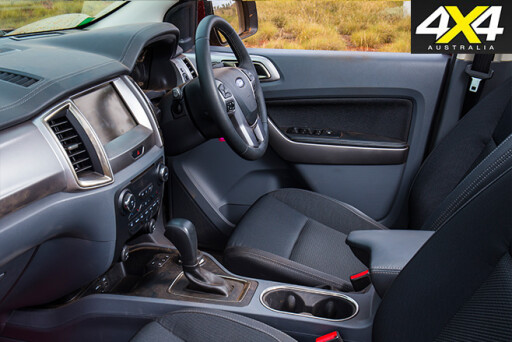 Getting on to the dirt confirmed our early experiences with the Everest: its on-road assuredness transposes beautifully to dirt tracks. Obvious early on is the fantastic body control; the Everest settles very well over bumps and recovers swiftly, and it’s not fazed by multiple lumps. Push on along snaking trails and the Everest is borderline sporty, ably quelling bumps and thumps and accurately tracking the path the driver directs of it.
Getting on to the dirt confirmed our early experiences with the Everest: its on-road assuredness transposes beautifully to dirt tracks. Obvious early on is the fantastic body control; the Everest settles very well over bumps and recovers swiftly, and it’s not fazed by multiple lumps. Push on along snaking trails and the Everest is borderline sporty, ably quelling bumps and thumps and accurately tracking the path the driver directs of it.
Yet at the same time it’s relatively comfortable; there’s some firmness, but it’s well controlled and ultimately compliant. Team that with fantastic front seats and a good driving position and it makes for easy days in the saddle.
Its 3.2-litre five-cylinder engine is also an asset worth plenty out here. With 470Nm it’s loaded with pulling power and it puts it to good use through an intelligent six-speed auto. As well as quickly slotting into gears when it’s told to, it does a good job of pre-empting the terrain, quickly readying itself for cresting a sand dune, just for example.
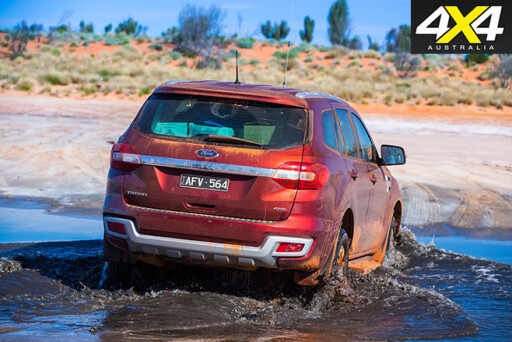 The effort engineers have put into the 4WD system and its Terrain Management System is also apparent. We’d love the Rock setting to be available in high range, though; the reality is most of the Canning is run in 4H, yet there are decent rocky outcrops where it would be handy to access the tailored throttle responses that come with that setting.
The effort engineers have put into the 4WD system and its Terrain Management System is also apparent. We’d love the Rock setting to be available in high range, though; the reality is most of the Canning is run in 4H, yet there are decent rocky outcrops where it would be handy to access the tailored throttle responses that come with that setting.
Engineering excellence is high on the Everest’s agenda, but it’s something you pay for. At $60,990 for the Trend – the base Ambiente has a cheaper cabin feel and tiny screen for the sound system – it’s towards the upper end of this quartet, bringing navigation and radar cruise control, as well as 18-inch wheels, an inch up on its three rivals.
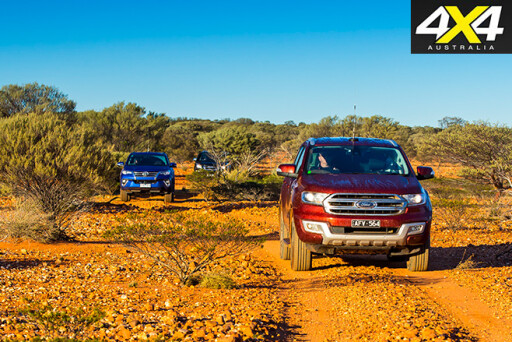 Specs: Ford Everest Trend
Specs: Ford Everest Trend
Price $60,990
Engine 3.2-litre 5-cyl turbo-diesel
Maximum power 143kW @ 3000rpm
Maximum torque 470Nm @ 1750-2500rpm
Gearbox six-speed automatic
4x4 system dual-range full-time
Crawl ratio 38.6:1
Tyre spec 265/60R18 H/T
Kerb weight 2407kg
GVM 3100kg
Payload693kg
Towing capacity 3000kg
Fuel tank capacity 80L
ADR fuel use claim 8.5L/100km
Test fuel use 12.4L/100km
Touring range 595km
Ground clearance 225mm
Wading depth 800mm
Approach angle 29.5
Departure angle 25.0
Rampover angle 21.5
L/W/H/W 4892/1860/1837/2850
 Ad blue
Ad blue
THE Everest was the only car in our group requiring AdBlue, an additive injected into the exhaust gases to clean diesel emissions. Pop the fuel filler and there’s a second, smaller cap clearly marked AdBlue.
In most cases AdBlue will be topped up at regular services, with Ford claiming that in regular around-town use or when cruising on a freeway the 20-litre supply should last between 12,000km and 18,000km.But once you’re off-roading or towing the range can drop to as little as 3000km.
Refilling is easy, just pop the cap and feed in the custom nozzle that comes with the typically 20-litre drums. Keep in mind it’s only available at selected roadhouses.
But before embarking on an adventure like the CSR, check the estimated range on the trip computer display to make sure you’ll get to your destination without running out. While the cars themselves can run fine without AdBlue, the computers are instructed to shut them down once they’ve run out because they will no longer meet the emissions regulations they were designed for.
SHOCKING STUFF
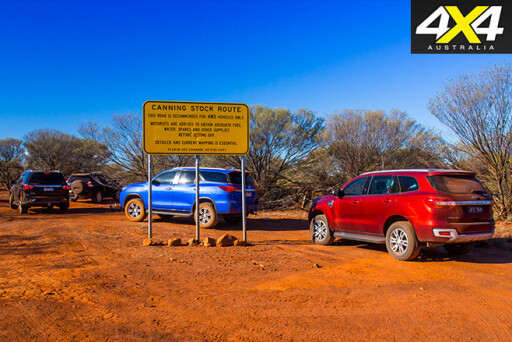 THE Canning Stock Route is known for killing shock absorbers, something we were conscious of going into this epic adventure. We didn’t want to overheat them to the point of failure, so we carried an infrared thermometer gun to measure shock temps after the punishing corrugations either side of Kunawarritji. There’s about 60km of really bad corrugations, and many people take them at a bone-jarring 10km/h.
THE Canning Stock Route is known for killing shock absorbers, something we were conscious of going into this epic adventure. We didn’t want to overheat them to the point of failure, so we carried an infrared thermometer gun to measure shock temps after the punishing corrugations either side of Kunawarritji. There’s about 60km of really bad corrugations, and many people take them at a bone-jarring 10km/h.
Measuring the temperatures isn’t an exact science, partly because it’s sometimes difficult to access the shocks. On the rears, for example, one side sits ahead of the axle and the other behind, so it’s hard to pick a common spot to take the temperature. But it at least allowed us to check whether the shock absorbers were peaking at a certain temperature, and how long it took them to cool down.
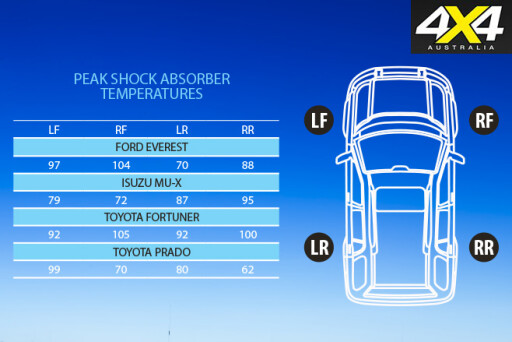 The highest temp we saw was 105°C, obviously measured on the outside of the shock; the oil inside would have been hotter again. Parking the cars for just five minutes pulled between 10°C and 15°C out of each shock absorber.
The highest temp we saw was 105°C, obviously measured on the outside of the shock; the oil inside would have been hotter again. Parking the cars for just five minutes pulled between 10°C and 15°C out of each shock absorber.
The Fortuner and Everest each saw shock temps above 100°C on the fronts, with the rears much cooler. The MU-X had by far the coolest shock absorbers. That may be because its shocks don’t seem to be working as hard to control the car, but also because at 2.1 tonnes it is a fair bit lighter than its competitors.
THE WINNERS
ALL four Canning contenders did the trip easily, without so much as a flat tyre. But some did it more capably and comfortably than others.
If you want a set-and-forget off-roader that will tackle the Canning without the need for extra fuel capacity, look no further than the Prado. That 150-litre tank alone makes it a winner out here, although you pay for it.
 The Fortuner is tough and capable, but smaller than its rivals. Some extra work controlling the suspension would make it a better device over this sort of terrain.
The Fortuner is tough and capable, but smaller than its rivals. Some extra work controlling the suspension would make it a better device over this sort of terrain.
The MU-X was our biggest surprise, but only once the going got rough. It’s not as convincing on-road, which is a major consideration when getting to wherever it is you want to explore.
The Everest’s excellent 4WD system and grunty engine set the groundwork for what is a classy, well adapted off-roader. Throw in great suspension tuning and a comfortable body and it amounts to a Prado-beating package, even in the heat of the outback.

COMMENTS